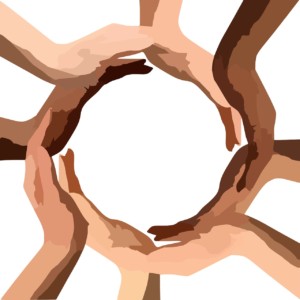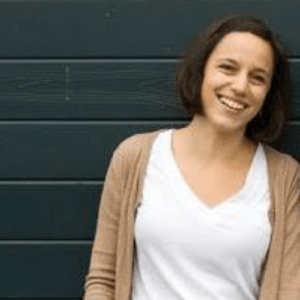By Rachel Caldwell for EDRBlog.org
“Vulnerability is the birthplace of innovation, creativity, change” – Dr. Brené Brown
Stepping into Vulnerability
 I recently joined fifteen peers from my professional network to participate in a workshop designed to tackle challenging topics on personal and professional values, ethics, and morals. The workshop provided a forum for us to discuss our own values and viewpoints, while learning strategies for facilitating these conversations within our broader networks. I was immediately drawn to this opportunity for the chance to uncover my own perspectives, hear from my peers, and expand my facilitation skills. I gained so much from this experience, but the lesson that has had the greatest impact is far from what I expected.
I recently joined fifteen peers from my professional network to participate in a workshop designed to tackle challenging topics on personal and professional values, ethics, and morals. The workshop provided a forum for us to discuss our own values and viewpoints, while learning strategies for facilitating these conversations within our broader networks. I was immediately drawn to this opportunity for the chance to uncover my own perspectives, hear from my peers, and expand my facilitation skills. I gained so much from this experience, but the lesson that has had the greatest impact is far from what I expected.
On the second day of the workshop, we sat in a circle sharing our viewpoints on a particularly sensitive subject, and I spoke up to offer my thoughts. Although I began speaking with confidence, as I went on, the faces around me began to change. My confidence faded to embarrassment as I realized I unintentionally said something that deeply offended my peers. When I finished speaking, a flood of retorts followed as people pointed out the uncomfortable issue with my statement. Horrified, I struggled to defend myself, but my stammered explanation did nothing to undo the damage. Though I felt my comment was misunderstood, I was being held rightfully accountable for what I’d said. I regretted speaking at all, wishing I’d never exposed myself to this judgment. In that moment, facing the admonishment of my peers, profound shame ran through me.
Get notified when new articles are posted to the EDR blog – sign up for our email list »
The feeling of shame lingered throughout the day. The conversation that morning moved on quickly—and my peers probably did, too—but I couldn’t move on. I couldn’t shake the shame. The rest of the day, I hardly spoke, I avoided eye contact, and I retreated to my hotel room as soon as I could. That evening, I began searching for stories and articles on getting over a shameful experience. I needed to know how to let go of this feeling. Predictably, perhaps, one link led to another until I arrived at Dr. Brené Brown’s renowned Ted Talk: “The Power of Vulnerability.”
Dr. Brown reasons that failure and authenticity, not impermeability and perfection, are fundamental to human connection. Her talk emphasizes the importance of vulnerability within all aspects of a person’s life—but her philosophy applies masterfully to the human experience of conflict resolution. The idea that risk, emotional exposure, and imperfection are not flaws but rather are essential to progress provided me with a roadmap to move past my shame and cast a light of gratitude on my experience. I saw my vulnerability as an asset—not an error—and the shame I felt became a path forward, not a dead end.
Trust and Empathy: The Foundation of Vulnerability
Conflict resolution demands vulnerability. Vulnerability is essential to exposing the values driving any conflict, and many conflicts are, at the core, a conflict of values. Values mold the perspective and needs participants bring to the conflict resolution table, and it is only through sharing values that a group can arrive at understanding, progress, and resolution. However, exposing values requires incredible vulnerability. In her speech, Dr. Brown powerfully asserts that “vulnerability is the birthplace of innovation, creativity, and change,” and this gets at the core of conflict resolution. Conflict resolution is all about change—changing positions, processes, or relationships to change an outcome and resolve a conflict. Vulnerability, then, is fundamental to any conflict resolution process.
And if vulnerability is the birthplace of innovation, creativity, and change, then trust and empathy are the foundation vulnerability rests upon. Without trust and empathy, there is no space for vulnerability or the growth that occurs through being vulnerable and feeling shame. As participants step into vulnerability to reveal their values, they must be able to trust their peers to accept and welcome their values and support them in their vulnerability. And if they say something challenging or hurtful—as I unintentionally did during that workshop—they have to trust that their partners will forgive them. Hopefully, they can also trust the intent of their peers whose values might offend them, whether intentional or not. When I arrived at the workshop the morning after my uncomfortable comment, I trusted my peers to forgive my verbal blunder, and to trust that despite my botched word choice I was a good person with good morals. Without this trust, moving on from the previous day’s experience would have been incredibly difficult, if not impossible.
Mutual trust helps people show and accept vulnerability, but if the vulnerability offered is not also met with empathy, the foundation of conflict resolution collapses. When shame is met without empathy, the vulnerable person can’t continue. Instead, blocked by their shame, they may retreat, attack others, become stuck in ‘analysis paralysis,’ or relent to make amends. All of these outcomes impede the conflict resolution process by obstructing genuine collaboration. But, as Dr. Brown says, “shame met with empathy cannot survive.” When shame is met with empathy, trust increases, leading to more vulnerability, more progress, and ultimately to change.
For Facilitators: The Vulnerability Road Map
Facilitators should embrace vulnerability in conflict resolution for the opportunity it creates to affect change. It is also our role to encourage the trust and empathy needed to support vulnerability. As facilitators, we will witness vulnerability as it is met with or without empathy and trust. Instead of redirecting the experience to avoid vulnerability altogether, we can guide participants through the process of being vulnerable, and help them give and accept the trust and empathy needed to move through shame and toward resolution.
After my experience, I began to think of conflict resolution as a complex road trip. Together, facilitators and participants depart from the doorstep of vulnerability, drive through shame, and eventually arrive at change—and through that journey, resolution is achieved. It is our responsibility as facilitators to ensure participants don’t get lost along the way. When vulnerability isn’t met with empathy, individuals veer off the road—detoured by retreating, relenting, or other defense tactics. Further, the entire journey is fueled by trust and empathy—without these, we run out of gas, leaving the process stranded and smoking on the side of the road. By making sure the car is fueled with plenty of trust and empathy, and providing a road map for participants to follow as they navigate vulnerability, facilitators can help the group stay on the road to change and achieve resolution.
Facilitators, too, can model vulnerability and its outcome for participants. We can take a risk, show emotions, and be imperfect. We should be vulnerable, and ask for empathy in return. By demonstrating that vulnerability is a strength, and that the outcomes far outweigh the discomfort, we are more likely to draw out vulnerability from participants. In taking the first step, we ask for trust and empathy—and begin to build this foundation among participants. Trust and empathy helped me move past my vulnerable experience, but also enabled me to step into vulnerability in the first place. Having built trust and established empathy with my peers throughout the first day, I felt safe being vulnerable and expressing my thoughts that morning. While the short-term effects were uncomfortable, and I experienced moments of regret, I know that without the trusting and empathetic environment we created, I wouldn’t have spoken up at all.
Dr. Brown said it best: “Vulnerability is not weakness. And that myth is profoundly dangerous.” Vulnerability is scary, shame is uncomfortable, and while stepping into vulnerability can be difficult, it is also imperative. Facilitators can demonstrate vulnerability and the strength it requires—and demonstrate for participants the benefit of stepping into vulnerability. Part of our role should also be to ask for vulnerability from participants, and encourage participants to support each other in this experience. As facilitators, and when we come to the table as participants, we should challenge the stigma surrounding vulnerability and embrace the need for vulnerability in conflict resolution.
 Rachel Caldwell is a program coordinator for National Parks Conservation Association. With a focus on conservation advocacy, Rachel helps partners identify policy and on-the-ground solutions to conservation challenges across the Greater Yellowstone Ecosystem. She has a background in natural resources conflict resolution, as well as experience facilitating multi-party processes relating to natural resource, environmental justice, and land-based conflicts. Rachel holds an M.S. in Environmental Studies and a graduate certificate in Natural Resources Conflict Resolution from the University of Montana.
Rachel Caldwell is a program coordinator for National Parks Conservation Association. With a focus on conservation advocacy, Rachel helps partners identify policy and on-the-ground solutions to conservation challenges across the Greater Yellowstone Ecosystem. She has a background in natural resources conflict resolution, as well as experience facilitating multi-party processes relating to natural resource, environmental justice, and land-based conflicts. Rachel holds an M.S. in Environmental Studies and a graduate certificate in Natural Resources Conflict Resolution from the University of Montana.
